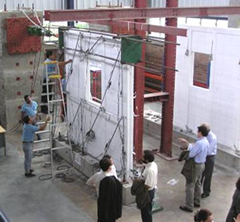El Salvador-Japan-Mexico TAISHIN (Earthquake-Resistant Popular Housing) Project
JAPAN-MEXICO PARTNERSHIP PROGRAMME (JMPP)
The government of Japan signed the Japan-Mexico Partnership Programme (JMPP) with the government of Mexico in 2003. The purpose of the program is to reinforce bilateral technical cooperation and to extend joint technical cooperation to other developing countries. In planning the JMPP, Japan supports Mexico’s South-South Cooperation to transfer its technical knowledge, gained through the bilateral programs offered by Japan in the past, in order to jointly promote effective development in other beneficiary countries. The scheme of the JMPP is composed of various modalities such as Dispatch of Mexican Experts, Third Country Training Programmes (TCTPs), and Trilateral Cooperation Projects.
The TAISHIN Project: A Mexican success story for South-South Cooperation
The TAISHIN (“Earthquake-Resistant Popular Housing”) project is seen as one of the most successful examples of South-South Cooperation developed under the JMPP framework.
In January and February of 2001 two earthquakes hit El Salvador, devastating the country and destroying 164,000 houses, which accounted for 11.68 percent of all housing in the region. Following this catastrophic event, El Salvador’s Vice Minister of Housing and Urban Development and JICA established the TAISHIN project, thus organizing the reconstruction efforts along with other stakeholders. The Mexican government, in consultation with the JICA Mexico Office, offered to assist the project. In fact, Mexico had received Japanese assistance for similar reconstruction efforts after a severe earthquake hit Mexico City in 1985. Mexico’s National Center for Disaster Prevention (CENAPRED), which was originally established with Japanese assistance and had received technical knowledge transfer from Japanese experts, now offered its technical knowledge to El Salvador.

This project was executed from 2003 to 2008 as a trilateral cooperation project of El Salvador, Japan and Mexico and successfully achieved the following objectives:
- Construction of a Large Structure Laboratory;
- Training for technical experts and researchers;
- Research on construction materials and building structures;
- Dissemination of the research results; and
- Development of an integral pilot program for improved low cost housing.
Many of the typical natural advantages of South-South Cooperation in the Latin American region came into play with the TAISHIN project. Mexican technical experts and their Salvadoran counterparts not only share the same language, but possess comparable cultural traits and customs. Moreover, construction norms and living conditions are very much alike in both countries, allowing for a more seamless and fluid transfer of knowledge.
Additionally, Japan and Mexico offered a vital and strategic combination of inputs and technical assistance. The resulting cost-benefit advantages were significant with benefits clearly outweighing the costs. The project received equipments, tools and experts on building structure from Japan, and Mexican experts offered technical assistance to ensure the efficient use of these resources.
The creation of an open and friendly environment for researchers and experts from the three countries was also crucial. The Mexican experts from CENAPRED, who were trained in Japan during the 1990s, now shared their knowledge and experience with the Salvadorans. There was a close collaboration between the Japanese and Mexican technical experts, who worked hand-in-hand with their Salvadoran counterparts. All worked as a team and were in tune with each other’s needs.
Building on its great success, the TAISHIN project has now entered its second phase since December 2008, with the objective to establish a sustainable system for further dissemination and application of the research results on housing improvements derived from the first phase of the project between 2003 and 2008. This endeavor has involved strengthening the capacity of institutions to spread the earthquake-resistant popular housing across the country and the establishment of appropriate construction norms.
A key component for the success of the TAISHIN project is that all the stakeholders viewed this South-South Cooperation as a “perfect fit” for their needs. As Sandra Viana, one of the JICA El Salvador staff members in charge of the TAISHIN project, commented, “The Salvadoran people simply fell in love with this project.” No one could have said it better.




scroll